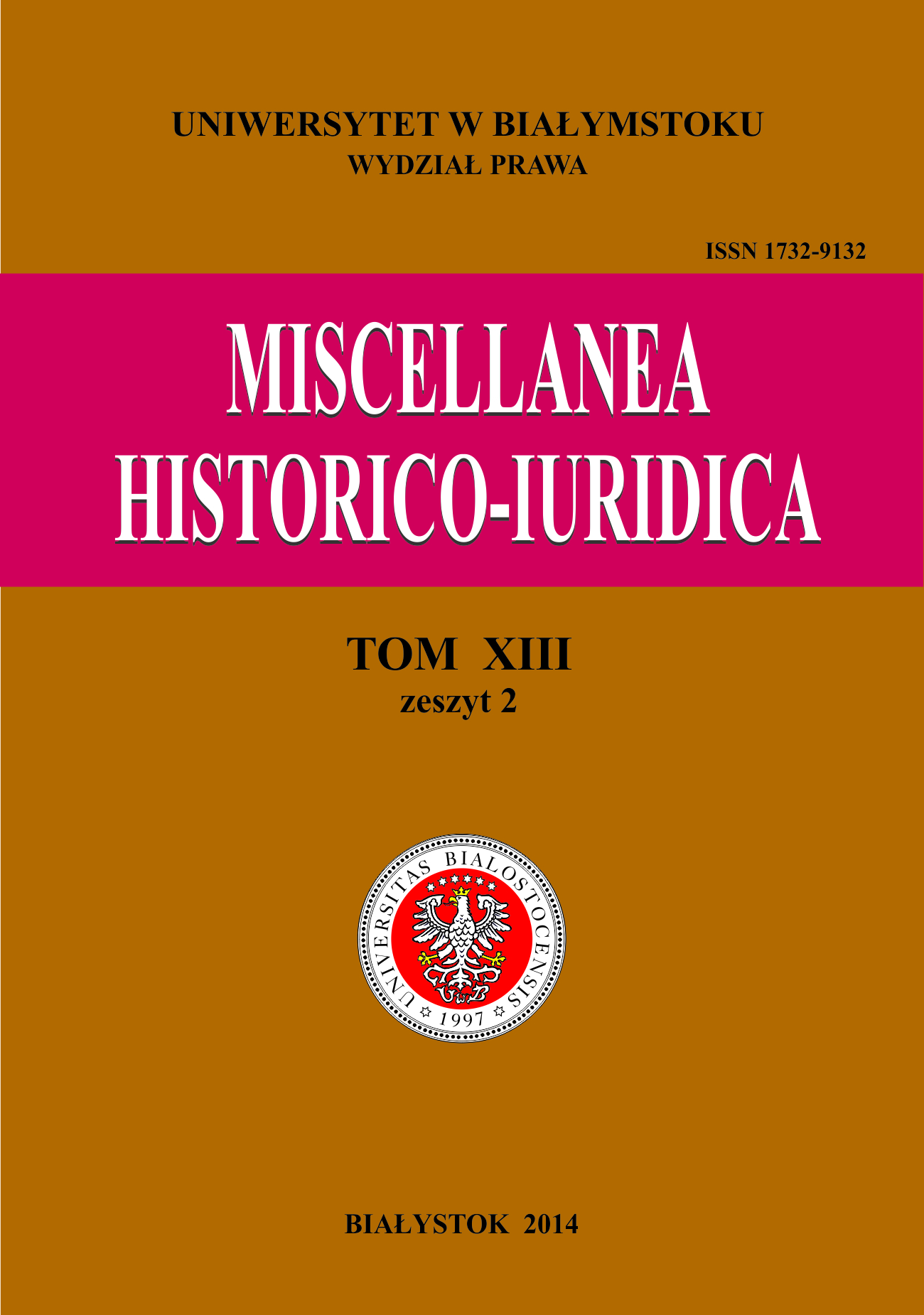Extramarital Relations among Jews in the Ottoman Empire
Słowa kluczowe:
związki pozamałżeńskie, Żydzi, Imperium ottomańskieAbstrakt
The present paper deals with the ways in which Jewish communities in the Ottoman Empire handled cases of extramarital relations (fornication) among Jewish men (married or unmarried) and unmarried women. The present study covers a wide range of Jewish legal sources from the beginning of the 16th century to the last decade of the 19th century. As we have seen, the occurrence of sexual relations out of wedlock for married men, or unmarried men and unmarried women, was an extant feature of Jewish society; it was almost certainly much more widespread than adultery. Particularly common were relations between the betrothed, usually leading to marriage. Similarly, cases were common of unmarried women, often maidservants in Jewish homes, who had sexual liaisons with different men. Most of the surviving sources deal with women’s pregnancy and their demands that the men marry them, or at least acknowledge their paternity and pay child support for the babies. Jewish society stood guard over its sexual morality, deliberating about cases of extramarital pregnancy within the confines of the local legal court. The communities’ supervision of sexual morality led to the enactment of new decrees in some places and in rare cases, the offenders involved would be punished by lashes. We learn that Jewish society attempted to conceal sexual offenses from the eyes of the Muslim rulers.
Bibliografia
Bassan Y., Yehiel Bassan Responsa (Constantinople: Yona b, Yaacov, 1737), No. 34.
Benveneste H., Ba’ei Hay’e Responsa, Even ha-Ezer (Salonica: Israeliga, 1788), No. 6.
Ben Avi Zimra D., Radbaz Responsa, vol. 4 (New York: Otzar ha-Sefarim, 1978), No. 1296.
Ben Naeh Y., Jews in the Realm of the Sultans, Ottoman Jewish Society in the Seventeenth Century (Tubingen: Mohe Siebeck 2008).
Ben-Naeh Y., A Scandal in Istanbul, “East and Maghreb” 2008, no. 8 (in Hebrew).
Bornstein-Makovertsky L., The Structure, Administrative, Organization and Spiritual Life of the Sephardic Communities in the Ottoman Empire in the 16th–18th Centuries, [in:] The Sephardi Heritage, II: The Western Sephardim, ed. R. Barnett, W. Schwab (London: Grendon Northants, 1989).
Bornstein-Makovetsky L., Life and Society in Arta Community in the 16th Century, “Pe’amin” 1991, no. 45 (in Hebrew).
Bornstein-Makovetsky L., The Va’ad Berurei Averot as a Judical Body in Christian Spainand the Ottoman Empire, “Jewish Law Association Studies”, X (New York: Global Publications, State University 2000).
Bornstein-Makovetsky L., The Jewish Woman in Aleppo and the Norms of Modesty in the Ottoman Period (in Hebrew), [in:] Tova Cohen & Saul Regev, eds.,Woman in the East, Woman From the East: The Study of the Oriental Jewish Woman (Ramat-Gan: Bar-Ilan University 2005, in Hebrew).
Bornstein-Makovetsky L., A City of Sages and Merchants, the Jewish Community of Aleppo, 1492-1800 (Ariel: Ariel University Center, 2012, in Hebrew).
de Medina S., Rashdam Responsa (Lvov: Balaban: 1862), Hoshen Mishpat, No. 320.
Caro Y., Shulchan Aruch, Even ha-Ezer (Venice: Zagara, 1697), Nos. 26 #1–4 (in Hebrew).
Caro Y., Kesef Mishneh, Ishut (Matrimonial), Chapter 10#1; Talmud Bavli, Ketubot. P. 7b. (in Hebrew).
Cohen A., Pikali E., Jews in the Muslim Court of Jerusalem in the 16th Century: Society, Economic and Organization (Jerusalem: Ben Zvi Institute, 1993).
Cohen A., Pikali E., Jews in the Muslim Court of Jerusalem in the 17th Century: Society, Economic and Organization (Jerusalem 2010, in Hebrew).
de Boton M., Responsa (Izmir: Gabai, 1660), No. 26.
Freimann A. H., Jerusalem Regulations, [in:] Yizhaq Baer et al, eds, Dinaburg Jubillee Book, (Jerusalem 1949, in Hebrew).
Gavizon M., Responsa, Eliav Shochatman (ed.), vol. 2 (Jerusalem: Jerusalem Institute,1985), Even ha-Ezer, No. 5.
Grossman A., Pious and Rebellious: Jewish Women in Medieval Europe (Lebanon, New Jersey: Tauber, 2004).
Hacker J.R., Jewish Autonomy in the Ottoman Empire – Its Scope and Limits: Jewish Courts from the Sixteenth to the Eighteenth Centuries, [in:] Avigdor Levy, ed.,The Jews of the Ottoman Empire (Princeton: Darwin Press, 1994).
Hacohen S.,Maharshach Responsa, vol. 3 (Jerusaem: Zichron Aharon, 2011), No. 30.
Hadar G., Carmen Salonica – Gender in,Family and Tension among. Jewish Women Tobacco Workers, “Pe’amim” 2006, no. 107, in Hebrew).
Heyd U., Studies in Old Ottoman Criminal Law, ed. V. L. Ménage (Oxford: Oxford University Press, 1973).
Horowitz E., Masters and Women Servants in Jewish Society in Europe during Late Middle Ages and Early Modern Periods, [in:] Sexuality and the Family in History, ed. Israel Bartal, Isaiah Gafni, (Jerusalem: Shazar, 1998, in Hebrew).
Hutsin T., Mishpat u-Tsedakah Responsa, Even ha-Ezer (edition by Rabbis Mordechai Lopez & Rabbi Yitzhak Nissim (Tel Aviv: Privately published, 1975), No. 1.
Katsin Y., Machane Yehuda Responsa (Jerusalem: Ahavat Shalom, 1989), Nos. 12, 30-32, 34.
Lamdan R., Deviations from the accepted moral norms in Jewish Society in Eretz Israel and Egypt in the 16th Century (in Hebrew), [in:] Sexuality and the Family in History, ed. Israel Bartal & Isaiah Gafni (Jerusalem: Shazar, 1998, in Hebrew).
Levy A., The Sephardim in the Ottoman Empire (Princeton, 1992).
Levy A., (ed.) The Jews of the Ottoman Empire (Princeton, New Jersey: 1994).
Mayo Y., sa Sefat ha-Yam Responsa (Salonica, Bezalel Ashkenazi, 1818), Even ha-Ezer, No. 12.
Meyuchas A., Bene Avraham Responsa (Costantinople: Ashkenazi, 1773), Even ha-Ezer. No. 26.
Mitrani M., Mabit Responsa, vol. 1 (Venice 1629: Yoani Kalioni), No. 323.
Mizrachi E., [in:] Rabbi Eliyahu Ibn Haim, Maim Amukim Responsa, (Venice: Francisco Viseri, 1647), No. 1.
Moda’i N.H., Meimar Haim Responsa, [in:] Rabbi Haim Moda’i,Haim le-Olam Responsa, vol. 2 (Izmir: Di Sigura Press, 1879), Even ha-Ezer, No. 45.
Palagi A., Shema Avraham Responsa, vol. 1 (Salonica: Saadya Halevi Ashkenazi Pess, 1850),Yore De’ah, No. 23.
Palagi H., Haim ve-Shalom Responsa, vol. 2 (Izmir: Roditi Press, 1872), Even ha-Ezer, Nos. 35, 74.
Peters R., “Zina”, [in:] The Encyclopedia of Islam, second edition, (Leiden: Brill Online).
Peters R., Crime and Punishment in Islamic Law, Theory and Practice from the Sixteenth to the Twenty First Century (Cambridge: Cambridge University Press, 2005).
Piffano D., Nose ha-Efod Responsa, in his book Chagor ha-Efod, vol. 2 (Sofia: A. Assa Press 1928), No. 5.
Rozen M., A History of the Jewish Community in Istanbul, The Formative Years, 1453-1565 (Leiden – Boston: Brill, 2002).
Rozen M., The Last Ottoman Century and Beyond: The Jews of Turkey and the Balkans,1808-1945, vol. 1 (Tel Aviv: Tel Aviv Diaspora Institute, 2005).
Russell A., The Natural History of Aleppo, vol. 2 (London: G. G. and J. Robinson, 1794).
Schacht J.,Mīrāth, [in:] Encyclopaedia of Islam 7 (2nd ed.) (Leiden: Brill 1991).
Shabtai H., a Torat Haim Responsa, vol. 3 (Salonica: Nachman and Kanpilias, 1722), No. 52.
Tarsa H.S., Haim Shena’im Responsa (Izmir: Di Segura, 1861), No. 26.
Tov Assis Y., Sexual Behaviour in Mediaeval Hispano-Jewish Society, [in:] Jewish History [Essays in Honour ofC. Abramsky], ed. Ada Rapoport-Albert and Steven J. Zipperstein, (London: P. Halban, 1988).
Tsahalon Y.T., Maharitaz Responsa (Venice: Vendramin Press, 1694), No. 108.
Tzahalon Y.T., Responsa Maharitaz Hchadashot, ed. Yaacov Spigel, vol. 1 (Jerusalem: Jerusalem Institute, 1980), No. 29.
Trani Y., Maharit Responsa, 2 (Fiorda: Beer, 1700), Even ha-Ezer, No. 49.
Westreich E., Transitions in the Legal Status of the Wife in Jewish Law – A Journey Among Traditions (Jerusalem: Magnes Press, 2002, in Hebrew).
Zimra D.I., Radbaz Responsa, 3 (Fiorda: Zirendorf & Hayyim b. Zvi Hirsh Orphans Press, 1781), No. 536 (561).







